Interrelationship Among Soil Parameters and their Alteration with Seasonal Changes in the Soil of Bawal Town, Haryana
1
Department of Chemistry,
K.L.P. College,
Rewari,
Haryana
India
2
Department of Chemistry, RPSDC,
Balana, M. Garh,
Haryana
India
Corresponding author Email: coolpushpa85@gmail.com
DOI: http://dx.doi.org/10.12944/CWE.19.1.30
Copy the following to cite this article:
Yadav P, Sharma S. Interrelationship Among Soil Parameters and their Alteration with Seasonal Changes in the Soil of Bawal Town, Haryana. Curr World Environ 2024;19(1). DOI:http://dx.doi.org/10.12944/CWE.19.1.30
Copy the following to cite this URL:
Yadav P, Sharma S. Interrelationship Among Soil Parameters and their Alteration with Seasonal Changes in the Soil of Bawal Town, Haryana. Curr World Environ 2024;19(1).
Download article (pdf)
Citation Manager
Publish History
Select type of program for download
| Endnote EndNote format (Mac & Win) | |
| Reference Manager Ris format (Win only) | |
| Procite Ris format (Win only) | |
| Medlars Format | |
| RefWorks Format RefWorks format (Mac & Win) | |
| BibTex Format BibTex format (Mac & Win) |
Article Publishing History
| Received: | 2023-11-03 |
|---|---|
| Accepted: | 2024-05-15 |
| Reviewed by: | 
 Kumari Priyanka
Kumari Priyanka
|
| Second Review by: |

 Maphuti Kwata
Maphuti Kwata
|
| Final Approval by: | Dr. Shivraj Sahai |
Introduction
Soil acts as a medium to maintain balance between atmosphere and various habitats and key support for various atmospheric cycles. Every soil is comprised of water, air, organic content, minerals and microscopic animals. Numerous microbes and other living things find a home in soil because of its unique chemical composition and physical characteristics.1 It also act as a sources and sink for green house gases mainly CO2.It host various microorganisms, microscopic plants and animals and ensure their growth, function, abundance and diversity.2 The five primary soil processes—pollutant removal, biomass production, water, nitrate, and phosphorus cycling, and carbon sequestration can affect the soil's ability to support lifecycle of various organisms.3,4
Soil parameters exert a vital role in deciding the type of soil and its production ability. In addition to this, soil physiochemical parameters of a region can give idea about the type of crops should be grown there. Natural and anthropogenic factors are altering the soil parameters by many direct and indirect methods. Floods, earthquake, cyclones and adverse weather are some natural factors responsible for diversity of soils, but human activities are responsible for deterioration of soil quality and alteration in their parameters day by day.5,6 The result of which can be seen in degradation of soil fertility. Unprecedented industrial growth and urbanization are the major anthropogenic activities, which are responsible for soil pollution and alteration in their parameters. In our previous studies of Bawal area, soil nearby the Industrial disposed sludge was found contaminated and becomes acidic with depth.7 Climatic change also has a significant role in maintaining the soil ecological balance.8It is a major factor responsible for variations in soil parameters. Soil characteristics are influenced by biotic and abiotic variables, which changes with season and region.9 Soil microbial community regulates nitrogen cycle and organic matter disposal.10 Microbiological communities' abundance distributions, functions and composition are of great importance to soil structure of a region. Microbial population was reported to show decline in the soil of industrial area.11 The ecological framework of microorganisms is susceptible to modification in response to alterations in their surroundings.12 Mineralization and immobilization of phosphorous, disposal of organic matter, nutrient cycles are some chemical processes, which are sensitive to climatic change in moisture, temperature and soil composition.13 Type of vegetation, dense or shallow vegetation also get affected by soil moisture content, which ultimately gets altered by seasonal change. In the present study, we have tried to enlighten the influence of climatic change on soil physiochemical properties by analyzing the various soil samples in different seasons of Bawal Industrial area.
Study Area
Bawal Industrial area comes under Rewari District of Haryana. It is situated at NH-8 of Dehli- Jaipur national highway. It comprised of many large, medium and small scale Industries. Paper pulp industries, Glass, cement, steel processing, automobile and paint Industries are situated here.
 | Figure 1A: Map indicating Bawal town of Rewari district (Haryana)
|
Methods
Soil samples were collected from three different sites of industrial area Bawal at a distance of 2 km from each other. All the samples were collected from depth of 15 cm. These three sites were selected randomly and sampling was done in a period of December 2021 to August 2022. Soil samples were collected in three seasons, summer, rainy and winter respectively. Summer samples were collected in April, winter samples were collected in December and Monsoon samples in August. Samples were collected in plastic bags with proper labeling. These samples were air dried, sieved and stored in glass vials at 4? in the laboratory. Total nine samples were analyzed for their physiochemical parameters (Soil pH, Electrical conductivity, Organic Matter, Available Nitrogen, Phosphorous, Potassium, Magnesium and Sodium). Soil pH was determined by using pH meter, electrical conductivity by conductometer and Magnesium concentration was determined by EDTA titration. Available N was determined by Kjeldahl method14, P by Olsen method15, Na and K by Flame photometer16.
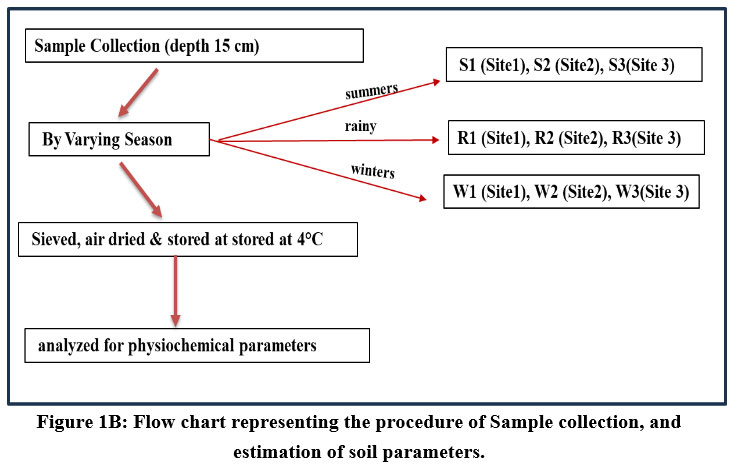 | Figure 1B: Flow chart representing the procedure of Sample collection, and estimation of soil parameters.
|
Results and Discussion
Soil parameters values of all collected samples in different seasons are given below in table1.Mean and standard deviations of all parameters are also mentioned in the same table. S1, S2, S3 are the parameters of three different sites during summers, R1, R2, R3 and W1,W2,W3 are in rainy and winter season respectively. Electrical conductivity was measured in mS/cm, OM in %, and N, K, P, Mg, Na in mg/kg.
Table 1: Seasonal values of soil parameters of three different sites.
| Parameters | Summer Season
| Mean | SD | Rainy Season
| Mean | SD | Winter Season
| Mean | SD | ||||||
| W1 | W2 | W3 | |||||||||||||
| R1 | R2 | R3 | |||||||||||||
| S1 | S2 | S3 | |||||||||||||
| pH | 7.3 | 7.5 | 7.6 | 7.466 | 0.152 | 7 | 6.6 | 6.7 | 6.766 | 0.2081 | 7.2 | 7.3 | 7.1 | 7.2 | 0.1 |
| EC | 0.86 | 0.87 | 0.9 | 0.876 | 0.020 | 1.14 | 1.23 | 1.09 | 1.153 | 0.0709 | 0.95 | 0.9 | 0.92 | 0.923 | 0.0251 |
| OM | 0.17 | 0.2 | 0.19 | 0.187 | 0.014 | 0.194 | 0.238 | 0.217 | 0.216 | 0.0220 | 0.256 | 0.271 | 0.268 | 0.265 | 0.0079 |
| N | 14 | 12 | 13 | 13 | 1 | 18 | 17 | 16 | 17 | 1 | 15 | 14 | 15 | 14.66 | 0.5773 |
| K | 15.5 | 16 | 15.7 | 15.73 | 0.251 | 16.02 | 16.35 | 16.48 | 16.28 | 0.2371 | 16.96 | 17.04 | 17.36 | 17.12 | 0.2116 |
| P | 26 | 25 | 28 | 26.33 | 1.527 | 29 | 27 | 30 | 28.66 | 1.5275 | 31 | 32 | 34 | 32.33 | 1.5275 |
| Mg | 5.5 | 5.7 | 5.9 | 5.7 | 0.2 | 5.1 | 4.95 | 4.91 | 4.986 | 0.1001 | 5.23 | 5.54 | 5.49 | 5.42 | 0.1664 |
| Na | 19 | 20 | 22 | 20.33 | 1.527 | 21 | 23 | 24 | 22.66 | 1.5275 | 24 | 25 | 27 | 25.33 | 1.5275 |
Table 2: Prediction of variation in Soil parameters due to seasonal change.
| Soil parameters | p values (Summer and rainy season) | p values (Winter and rainy season )
| p values (Winter and Summer season)
|
| pH | 0.0364 | 0.0482 | 0.0789 |
| EC(mS/cm) | 0.0015 | 0.0220 | 0.0831 |
| OM (%) | 0.0127 | 0.0144 | 0.0011 |
| N(mg/kg) | 0.0101 | 0.0364 | 0.0188 |
| K(mg/kg) | 0.0239 | 0.0040 | 0.0084 |
| P(mg/kg) | 0.010 | 0.0266 | 0.0045 |
| Mg(mg/kg) | 0.0265 | 0.0519 | 0.0303 |
| Na(mg/kg) | 0.010 | 0.0076 | 0.0032 |
Soil pH
Soil pH of all the collected samples are found in normal range (6.6 to 7.6).It has been observed that the pH was recorded lowest in rainy season and highest in summer season as shown in table 1 and fig: 2. High pH values in summer could be correlated to higher temperature as reported by Feng Jiao et al17 and lowest value in rainy season could be due to acidic nature of rain water. Soil pH increase with warmer climate and aridity, it could impart negative effects on soil OM, N, P content.17 Regression analysis of the same considering pH as dependent variable, showed that it is hardly depends upon OM, Na, Available P, and K of the soil. In contrast to it, Soil pH showed dependency on the electrical conductivity, Mg content and Available N of the soil as shown in fig: 4. Soil pH showed R2=0.890 with Mg, 0.758 with EC and 0.694 with Available N. Soil pH of this area found to show measurable variation in transition from summer to rainy (p= 0.0364) and rainy to winter season (p=0.0482), as their p values are <0.05. But no significant variation was observed in summer and winter season values (p= 0.0789) as shown in table 2.
 | Figure 2: Soil pH of all three sites in different seasons
|
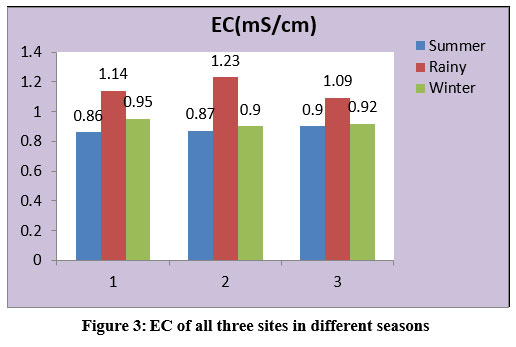 | Figure 3: EC of all three sites in different seasons.
|
Electrical Conductivity (EC)
EC of all analyzed samples found in range of 0.86 to 1.23 mS/cm. However its value was recorded highest in rainy season followed by in winter season and least in summers. EC in winter and summer seasons were almost comparable but significant difference was observed in rainy season as shown in fig: 3, which may be due to ionic enriched rainy water, which ultimately enriches the soil with ionic concentration. Presence of cations and anions in the soil could be due to industrial sludge disposal, are responsible for increase in EC of soil18. In addition to this, change in climatic conditions could also be the reason for variation in EC, which can further affect the various parameters and process of soil. Regression values highlighted its significant dependency on other soil parameters and found to follow the order; Available N (R2=0.766)> P (R2=0.758)>Mg (R2=0.716). Soil EC had reported negligible dependency on pH, Na, Available K and OM as shown in fig:5. Soil EC of this area also found to show significant variation in summer to rainy, rainy to winter season like pH but no significant change was observed in winter and summer season samples.
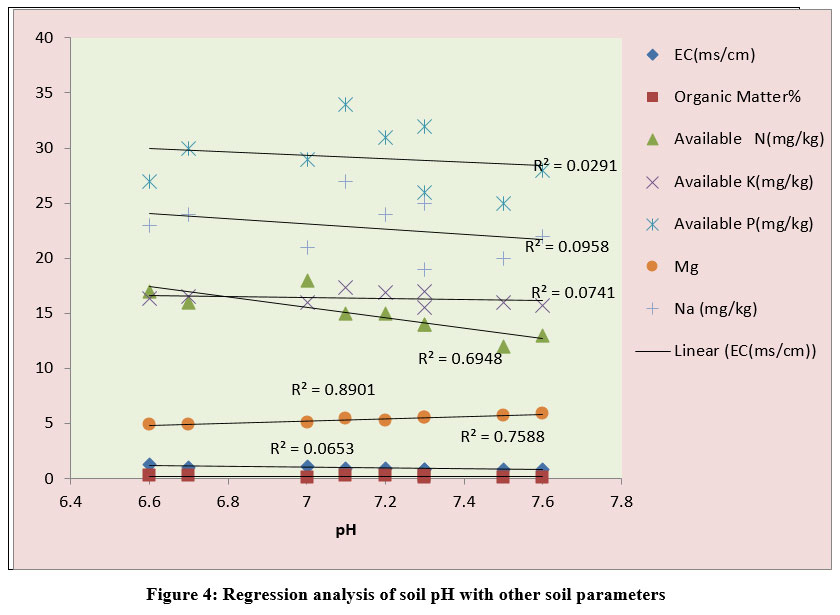 | Figure 4: Regression analysis of soil pH with other soil parameters
|
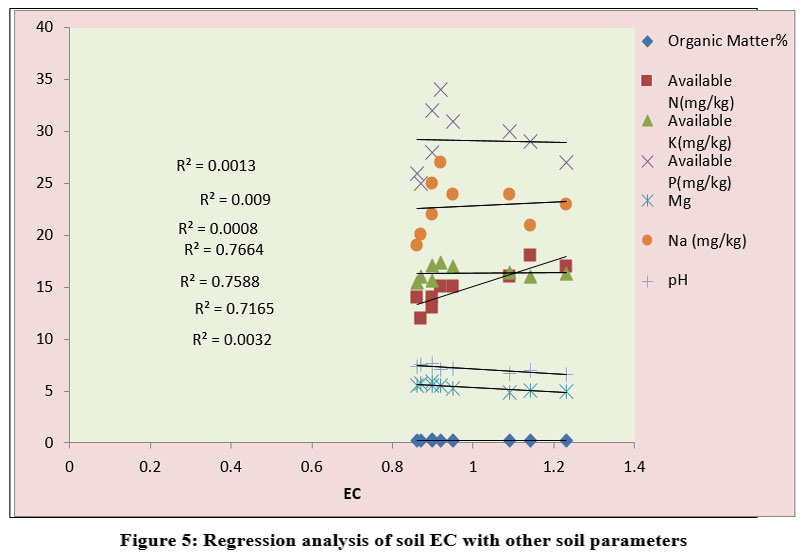 | Figure 5: Regression analysis of soil EC with other soil parameters.
|
Organic Matter (OM)
Soil organic matter has a prominent contribution in soil fertility. It is found in the range of 0.17 to 0.271 %. Samples of this region followed the pattern i.e. highest OM % in winters and lowest in summers (fig: 6). Cooler soil or soil in cooler climate shows greater organic content and this is further supported by the findings reported by Miko U.F. Kirschbaum et al.19 Reduced OM may be due to increased temperature in summers, which also affects the microbial population.19 OM of the soil of this region may get affected by the industrial development in this area. Multiple linear regression of OM with other soil parameters suggested the dependency of the same on Available K, P and Sodium content of the soil. Regression value of available K (0.931) with OM (as dependent variable) is highest, followed by Na (0.803) and available P (0.619) as reported in fig: 7. OM of this region had showed a remarkable change in their values in all season, as p values are less than 0.05. (Table 2).
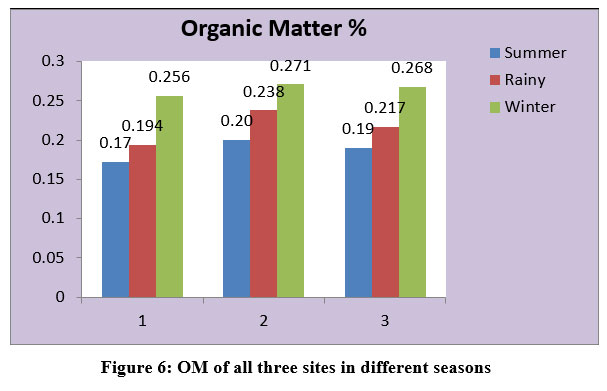 | Figure 6: OM of all three sites in different seasons
|
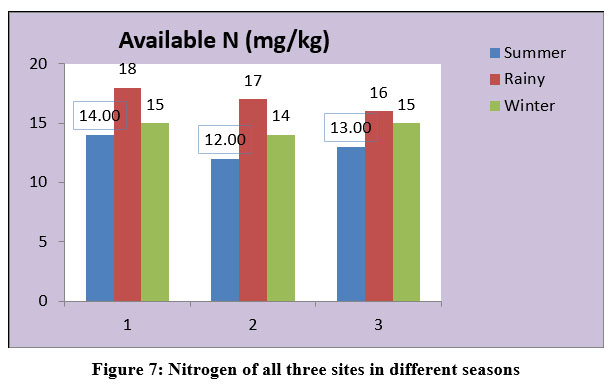 | Figure 7: Nitrogen of all three sites in different seasons.
|
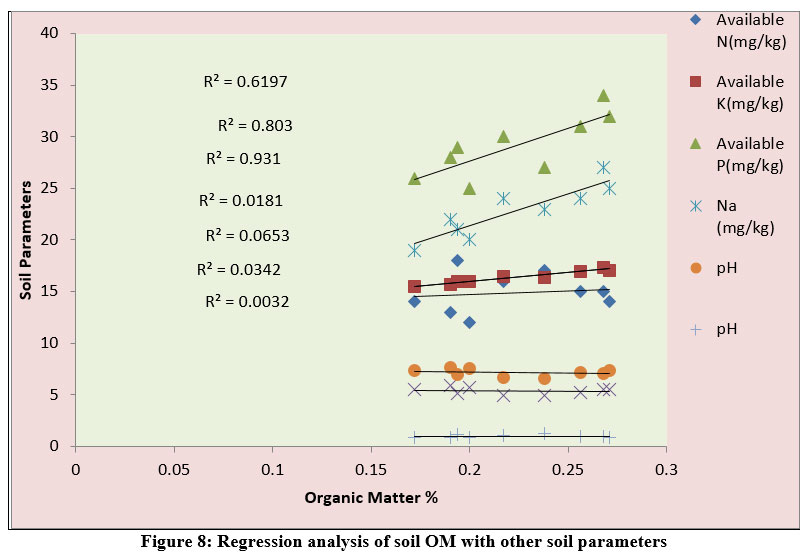 | Figure 8: Regression analysis of soil OM with other soil parameters
|
Available Nitrogen (N)
Seasonal analysis of soil samples revealed the significant climatic contribution in the variation of Available N content in soil of Bawal industrial area. Samples of rainy season were found to contain highest amount of nitrogen content as compared to summer and winter samples of same corresponding sites (fig:7). Highest N content during monsoon season can be explained by increased microbial activity in this season. Microbes release the nitrogen by nitrogen fixation cycle.20 Nitrogen content of soil of this area was reported in range of 12 to 18 mg/kg. Soil of first sampling site in rainy season had reported the highest concentration of nitrogen. Regression analysis of Available N (as dependent variable) suggested the highest R2 value of Mg(0.740 ), followed by soil pH(0.694) as shown in fig:9 Statistical analysis proved the significant variation in available N content with the change in season but a large variation was observed in summer to rainy season ( p= 0.0101) as reported in table 2.
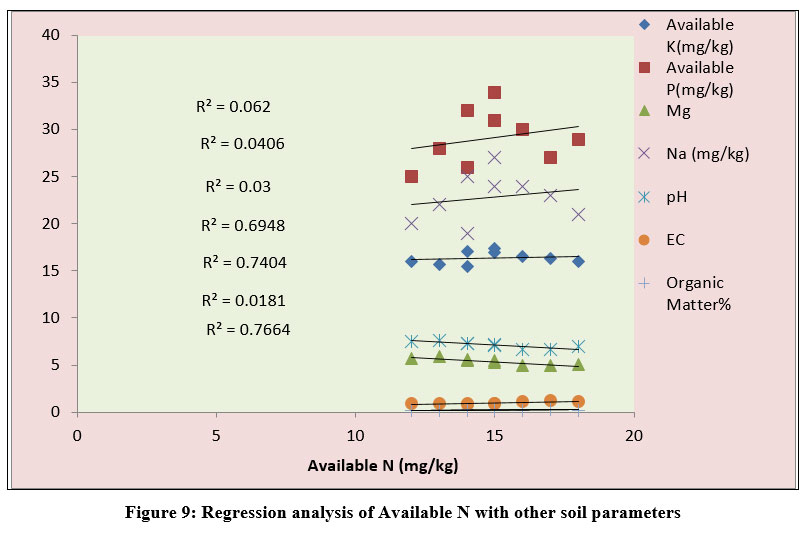 | Figure 9: Regression analysis of Available N with other soil parameters
|
Available Phosphorus (P) and Potassium (K)
P and K contents of soil exert a very important role in determining soil quality of a particular region. Both these parameters found to show maximum values in winter season followed by rainy and minimum in summer season as reported in fig: 10 and 11 respectively. P and K were reported in the range of 26 -34 mg/kg and 15.50 -17.36 mg/kg respectively. However P was reported to follow the pattern winter >summer> rainy season as reported by Rajdeo Kumar et al21 Various metabolic process and type of vegetation grown on the soil is greatly affected by available P content of the soil.22 On the other hand K has a vital role in catalyzing many enzymatic process and synthesis of proteins.23 As reported in fig:12, it showed a significant regression with OM (R2=0.931), Na (R2= 0.855) and significant regression with P (R2=0.758). Regression plot of K suggested the negligible regression with pH, EC, and Mg of the soil. A significant difference was observed in K and P content with change in season. All measured p values for P and K are less than 0.05 as reported in table 2.
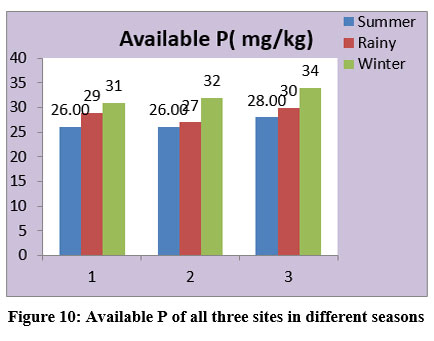 | Figure 10: Available P of all three sites in different seasons
|
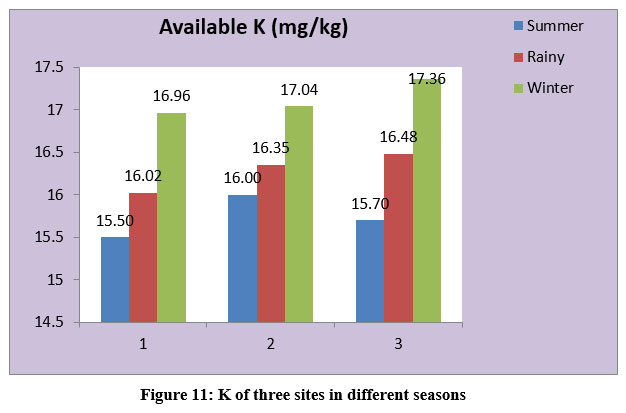 | Figure 11: K of three sites in different seasons
|
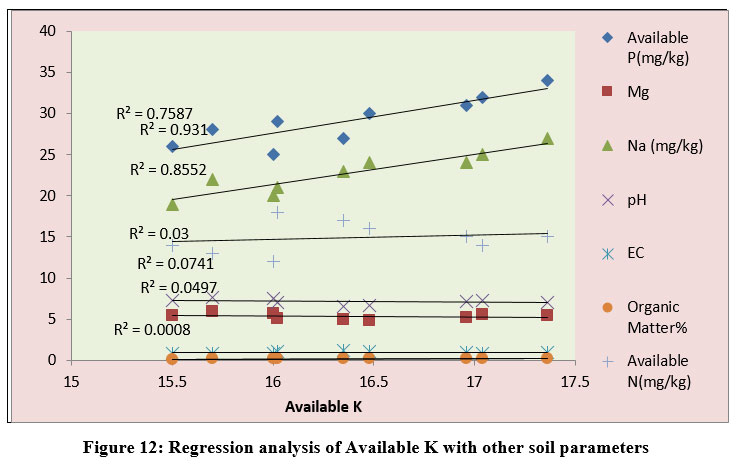 | Figure 12: Regression analysis of Available K with other soil parameters.
|
Available P of this region also found to report good regression with organic matter (R2=0.619), significant good regression with Na (R2=0.827) and K (R2= 0.758) as shown in fig: 13. It had also followed the same trend in regression values with Soil pH, EC and Mg as in K. Both, K and P content of this region showed very weak regression with available N.
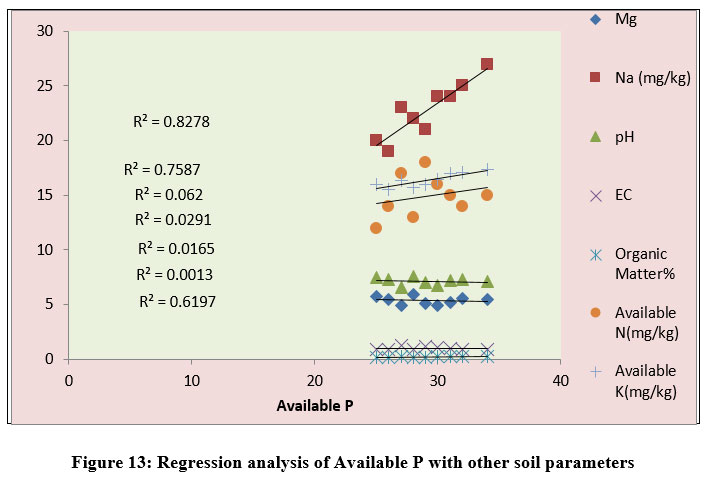 | Figure 13: Regression analysis of Available P with other soil parameters
|
Magnesium (Mg) and Sodium (Na)
Mg is required in trace amount by the plants and mobility of magnesium ion is reported low due to its high ionic charge.24 Its deficiency could leads to loss of healthy green colour in leaf, that starts from margins and higher levels of Mg does not impart direct negative effect on soil health but disturbs its potassium uptake efficiency.25 In this study, Soil pH, EC and Nitrogen content of the soil showed dependency on the magnesium content of soil. However Mg content was also found to get affected by Soil pH, EC and N in turn. (Fig: 16) As the regression values (R2) are; O.890, 0.716 and 0.740 respectively. Mg content was reported to follow the order; maximum in summers, followed by winter and least values were reported in monsoon season and was reported in the range of 4.91- 5.90 mg/kg. (Fig: 14) A slight variation in Mg content of this region was recorded due to seasonal change. p values suggested the a significant variation in sodium content as compared to Mg content with climatic change. On the other hand, no significant variation was observed in Mg content in rainy and winter season, as the p values are > 0.05.
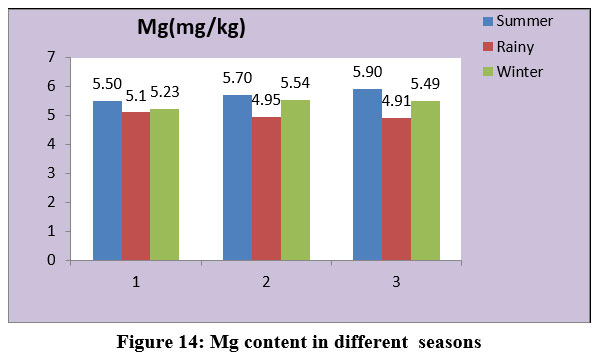 | Figure 14: Mg content in different seasons
|
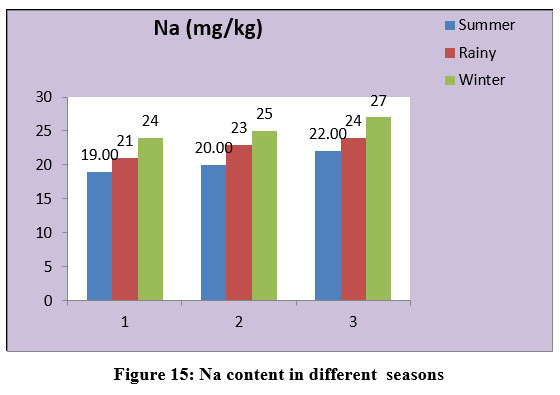 | Figure 15: Na content in different seasons.
|
 | Figure 16: Regression analysis of Mg content with other soil parameters.
|
Increased Na content in soil may impart negative effects on plant growth by alteration in permeability of soil. In our study area, its concentration was recorded highest in winter season and lowest in summers in the range of 19.0 -27.0. A large variation in Na content can be seen due to climatic change in soil of this area. (Fig: 15) Regression analysis confirms that its value gets affected by Soil OM, K and P content of the soil. As it had reported a significant regression with OM (0.803), K (0.855) and P (0.827) content of the soil. (Fig: 17). Non significant regression values were reported with N, EC, Mg and Soil pH.
 | Figure 17: Regression analysis of Na content with other soil parameters
|
Conclusion
Seasonal changes have marked a significant effect on soil physiochemical properties. Results showed the variation in soil parameters in different seasons. OM, K, P, and Na contents of the soil were found to follow the order of abundance; winter>rainy>summer. In contrast to this, Soil pH, and Mg contents had reported their highest concentration in summer followed by winter and least in monsoon season. Available N content and soil EC concentration were found highest in rainy season followed by winter and summer. However, the EC values in summer and winter season hadn’t shown much difference as compared to N content. All these findings revealed that the climatic condition of a region is also a contributory factor in variation of soil parameters. Multiple linear regression analysis of all soil parameters with other parameters throws a light on the relationship among them. Soil pH had found to show significant regression with Mg (0.890) followed by EC (0.758) and Available N (0.694). Interdependency of Mg and Soil pH can be concluded from this analysis. Na showed significant R2 with K (0.855), P (0.827) and OM (0.803). OM and K were showing significant R2 values (0.931), confirmed the dependency on each other. Nitrogen content of soil had found to show significant regression with EC and pH. Soil EC of this area showed significant R2 values with pH, N, and Mg. Paired t test with one tailed distribution was applied to soil parameters of winter and rainy season, summer and rainy season and for winter and summer season. A significant variation in OM, Available N, P, K, Mg, Na content was observed in samples of winter, summer and rainy season. No significant variation was seen in pH and EC values in summer to winter season, however a significant change was observed in summer to rainy and rainy to winter season. It can be inferred that climatic conditions had a profound effect on soil parameters, as the winters in this region are extreme winters and summers are also extreme. Almost all the measured parameters (except pH, and EC) had reported a measurable difference in their value with transition in weather.
Acknowledgement
The author(s) would like to thank Raffles University, Neemrana for providing opportunity for this research work.
Funding Source
No funding was received for this research work.
Conflict of Interest
The author(s) do not have any conflict of interest.
Contribution of Authors
Principal Author - Pushpa Yadav ( She has performed the experiments and prepared the whole manuscript.)
Co- author - Soma Sharma ( She has edited the manuscript and modified the conclusions.)
Data Availability Statement
The manuscript incorporates all data and results of experiments throughout this research study.
Ethics Approval Statement
This study does not involve any experiment on humans and animals.
References
- Ibe, I. J., Ogbulie, J. N., Orji, J. C., Nwanze, P. I., Ihejirika, C., and Okechi, R. N., "Effects of Palm Oil Mill effluent (Pome) on soil bacteria and enzymes at different seasons." International Journal of Current Microbiology and Applied Sciences, 3.10 (2014): 928-934.
- Onuh, M. O., D. K. Madukwe, and G. U. Ohia. "Effects of poultry manure and cow dung on the physical and chemical properties of crude oil polluted soil." Science World Journal, 3.2, (2008).
CrossRef - Hansen, J., Sato, M., Kharecha, P., Beerling, D., Berner, R., Masson-Delmotte, V., Pagani, M., Raymo, M., Royer, D.L. and Zachos, J.C., "Target atmospheric CO2: Where should humanity aim?" arXiv preprint arXiv: 0804.1126, (2008).
CrossRef - Lal, Rattan. "Soil carbon sequestration impacts on global climate change and food security." Science, 304.5677, (2004): 1623-1627.
CrossRef - Hirabayashi, Y., Mahendran, R., Koirala, S., Konoshima, L., Yamazaki, D., Watanabe, S., Kim, H. and Kanae, S.,"Global flood risk under climate change." Nature climate change, 3.9, (2013): 816-821.
CrossRef - Furtak, Karolina, and Agnieszka Woli?ska. "The impact of extreme weather events as a consequence of climate change on the soil moisture and on the quality of the soil environment and agriculture–A review." Catena, 231 (2023): 107378.
CrossRef - Yadav, P., Sharma, S., “Effect of hazardous Sewage and Industrial Effluents on Soil health and agriculture land of Bawal Industrial area (Haryana).” Journal of Environmental Science and Engineering-CSIR-NEERI, 3, (2021): 1270-1277.
- Grzesiak, M.T., Hordy?ska, N., Maksymowicz, A., Grzesiak, S. and Szechy?ska-Hebda, M., "Variation among spring wheat (triticum aestivum l.) genotypes in response to the drought stress. II—Root system structure." Plants, 8.12, (2019): 584.
CrossRef - Dar, Z. A., Humaira, Q., Ahmad, M. S., Bilal, B., and Amin, A.,"Assessment of physico-chemical parameters of forest soil of Hirpora Wildlife Sanctuary, Kashmir." International Journal of Advance Research in science and engineering, 7.4, (2018): 46-56.
- Waldrop, Mark P., and Mary K. Firestone. "Seasonal dynamics of microbial community composition and function in oak canopy and open grassland soils." Microbial Ecology, 52, (2006): 470-479.
CrossRef - Yadav, P., Sharma, M., Sharma, S., “Analysis of Soil Microbial count and water physiochemical parameters in villages near Industrial area, Bawal, Haryana (India), Journal of Chemical Health Risk, 13.4, (2023):2417-2422.
- White, D. C., Davis, W. M., Nickels, J. S., King, J. D., and Bobbie, R. J., "Determination of the sedimentary microbial biomass by extractible lipid phosphate." Oecologia, 40 (1979): 51-62.
CrossRef - McGrath, Deborah A., Nicholas B. Comerford, and Mary L. Duryea. "Litter dynamics and monthly fluctuations in soil phosphorus availability in an Amazonian agroforest." Forest Ecology and Management, 131.1-3, (2000): 167-181.
CrossRef - Indian Standards, Determination of Nitrogen and Nitrogenous Compounds in Soils; IS 14684:1999
- Olsen, S.R., Cole, C.V., Watanabe, F.S. and Dean, L.A. “Estimation of available phosphorus in soils by extraction with sodium bicarbonate.” Circ. U.S. Dept. Agric, 939, (1954): 1-19
- IS: 9497-1980, Indian Standard “Method for determination of Sodium and Potassium” (1981)
- Feng Jiao, Xin-Rong Shi, Feng-Peng Han, and Zhi-YouYuan, “Increasing aridity, temperature and soil pH induces soil C-N-P imbalance in grasslands.” Scientific reports, 6.1, (2016) : 19601
CrossRef - Yadav, P., Talukdar, S., Sharma, S.,“Impact of Covid-19 on contamination of soil by Heavy Metals- A Blessing towards Sustainablity.”European Chemical Bulletin, 11.10, (2022):458-465.
- Kirschbaum, Miko UF. "The temperature dependence of soil organic matter decomposition and the effect of global warming on soil organic C storage." Soil Biology and biochemistry, 27.6, (1995): 753-760.
CrossRef - Bergeron, Yves, et al. "Natural fire regime: a guide for sustainable management of the Canadian boreal forest." Silva fennica, 36.1, (2002).
CrossRef - Kumar, Rajdeo, et al. "Impact of seasonal variations on physico-chemical and exchangeable cations of forest soil in Doon Valley, Uttarakhand, India." Geology, Ecology, and Landscapes, (2021): 1-11.
CrossRef - Rai, Swapnil, et al. "Comparative study of some physicochemical parameters of soil irrigated with sewage water and canal water of Dehradun city, India." Archives of Applied Science Research, 3.2, (2011): 318-325.
- Brady, Nyle C., Ray R. Weil, and Ray R. Weil. The nature and properties of soils. Vol. 13. Upper Saddle River, NJ: Prentice Hall, 2008.
- Tukura, B.W., Yahaya, M., and Madu, P.C. “Evaluation of physicochemical properties of irrigated soils.” Journal of Natural Sciences Research, 3.9, (2013):135-139.
- Gransee, A., and H. Fuhrs. “Magnesium mobility in soils as a challenge for soil and plant analysis, magnesium fertilization and root uptake under adverse growth conditions.”Plant and Soil, 368, (2013):5-21
CrossRef






